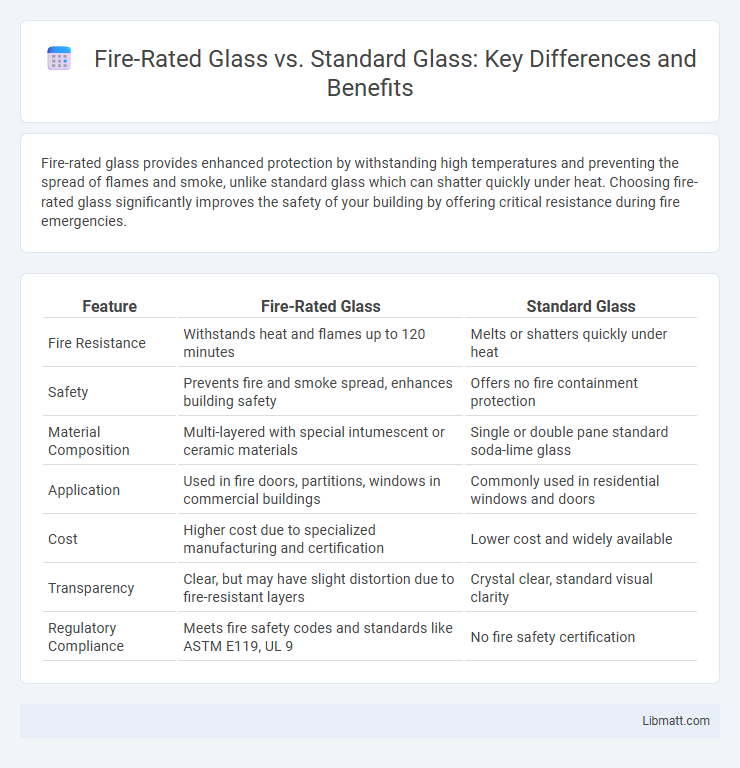Fire-rated glass provides enhanced protection by withstanding high temperatures and preventing the spread of flames and smoke, unlike standard glass which can shatter quickly under heat. Choosing fire-rated glass significantly improves the safety of your building by offering critical resistance during fire emergencies.
Table of Comparison
| Feature | Fire-Rated Glass | Standard Glass |
|---|---|---|
| Fire Resistance | Withstands heat and flames up to 120 minutes | Melts or shatters quickly under heat |
| Safety | Prevents fire and smoke spread, enhances building safety | Offers no fire containment protection |
| Material Composition | Multi-layered with special intumescent or ceramic materials | Single or double pane standard soda-lime glass |
| Application | Used in fire doors, partitions, windows in commercial buildings | Commonly used in residential windows and doors |
| Cost | Higher cost due to specialized manufacturing and certification | Lower cost and widely available |
| Transparency | Clear, but may have slight distortion due to fire-resistant layers | Crystal clear, standard visual clarity |
| Regulatory Compliance | Meets fire safety codes and standards like ASTM E119, UL 9 | No fire safety certification |
Understanding Fire-Rated Glass: Key Features
Fire-rated glass offers enhanced protection by withstanding high temperatures and preventing the spread of flames and smoke for a specified duration, unlike standard glass which shatters quickly under heat. It incorporates specialized interlayers or coatings that maintain integrity during a fire, ensuring safety and compliance with building codes. Your choice of fire-rated glass can significantly improve overall fire safety without compromising visibility or aesthetics in architectural designs.
What Makes Standard Glass Different?
Standard glass differs from fire-rated glass primarily in its composition and performance under high temperatures. It is typically made from annealed or tempered glass that provides clarity and strength but lacks the ability to resist heat and flames. Unlike fire-rated glass, standard glass does not offer significant thermal insulation or fire containment, making it unsuitable for fire safety applications.
Safety and Protection: Fire-Rated vs Standard Glass
Fire-rated glass provides enhanced safety by withstanding high temperatures and preventing the spread of flames and smoke for a specific period, unlike standard glass which shatters quickly under heat. Its specialized construction offers superior protection in fire emergencies, helping contain fire and allowing more time for evacuation. You can significantly improve building safety by choosing fire-rated glass in critical areas requiring fire resistance.
How Fire-Rated Glass Works in Emergencies
Fire-rated glass contains special intumescent interlayers or ceramic materials that expand and insulate when exposed to high temperatures, slowing heat transfer and preventing flames from breaching barriers during emergencies. This unique composition allows it to maintain structural integrity and visibility while protecting your property and occupants from fire and smoke. Unlike standard glass, which shatters quickly under heat, fire-rated glass provides critical time for evacuation and firefighting efforts.
Durability and Performance Comparison
Fire-rated glass offers superior durability and performance compared to standard glass by withstanding high temperatures and preventing the spread of flames and smoke during fire incidents. Its specialized composition includes multiple layers and intumescent interlayers that maintain structural integrity under extreme heat, unlike standard glass which often shatters quickly upon exposure. You benefit from increased safety and compliance with fire safety regulations when choosing fire-rated glass for your building applications.
Installation and Maintenance Requirements
Fire-rated glass requires specialized installation with fire-resistant frames and precise sealing to maintain its fire protection capabilities, unlike standard glass which has more flexible installation options. Maintenance of fire-rated glass involves regular inspections for cracks or damage to ensure compliance with fire safety standards, whereas standard glass maintenance is primarily concerned with aesthetics and minor repairs. Proper handling during installation and upkeep is critical for fire-rated glass to retain its integrity and performance in fire scenarios.
Applications in Residential and Commercial Architecture
Fire-rated glass is essential in both residential and commercial architecture for enhancing safety by containing flames and smoke during a fire. Its applications include fire doors, windows, and partitions in office buildings, schools, and homes, ensuring compliance with fire codes while maintaining visibility and natural light. Your choice of fire-rated glass improves property protection and occupant safety without compromising design aesthetics.
Cost and Budget Considerations
Fire-rated glass typically costs significantly more than standard glass due to its specialized materials and testing certifications essential for safety compliance. Budget considerations must include not only the initial purchase price but also potential insurance savings and regulatory incentives associated with fire-rated installations. Evaluating long-term value, fire-rated glass can reduce damage and downtime costs during fire events, offsetting its higher upfront investment.
Building Code Compliance and Legal Requirements
Fire-rated glass meets strict Building Code Compliance standards by providing essential fire resistance and smoke control, which standard glass lacks. Using fire-rated glass ensures Your building adheres to legal requirements for fire safety, reducing liability and enhancing occupant protection. Compliance with National Fire Protection Association (NFPA) and International Building Code (IBC) mandates often necessitates fire-rated glass in specific construction assemblies.
Choosing the Right Glass for Your Project
Fire-rated glass provides enhanced safety by resisting high temperatures and preventing the spread of flames, making it ideal for commercial buildings and fire-sensitive areas. Standard glass lacks these protective properties and is more susceptible to breakage under heat, limiting its use in fire-rated applications. Choosing the right glass for your project depends on meeting building codes and safety requirements while balancing aesthetics and functionality.
fire-rated glass vs standard glass Infographic

 libmatt.com
libmatt.com